Case Study on Keda's SAP Implementation and Business Strategy
VerifiedAdded on 2022/08/12
|8
|1548
|20
Case Study
AI Summary
This case study examines Keda's SAP implementation, a project undertaken by a small manufacturer to improve business processes. The assignment delves into the reasons behind Keda's decision to adopt ERP, driven by factors like government pressure and the need for better inventory management and innovation. The analysis covers the challenges faced, including vendor selection, team organization, and data collection. The study highlights leadership best practices, such as setting targets and fostering innovation. It further explores the strategies employed, emphasizing the benefits of third-party software and decentralized implementation. Ultimately, the case underscores the importance of employee value and a supportive culture in achieving successful ERP adoption and improved operational efficiency. The document provides a comprehensive overview of the implementation process, challenges, and outcomes.
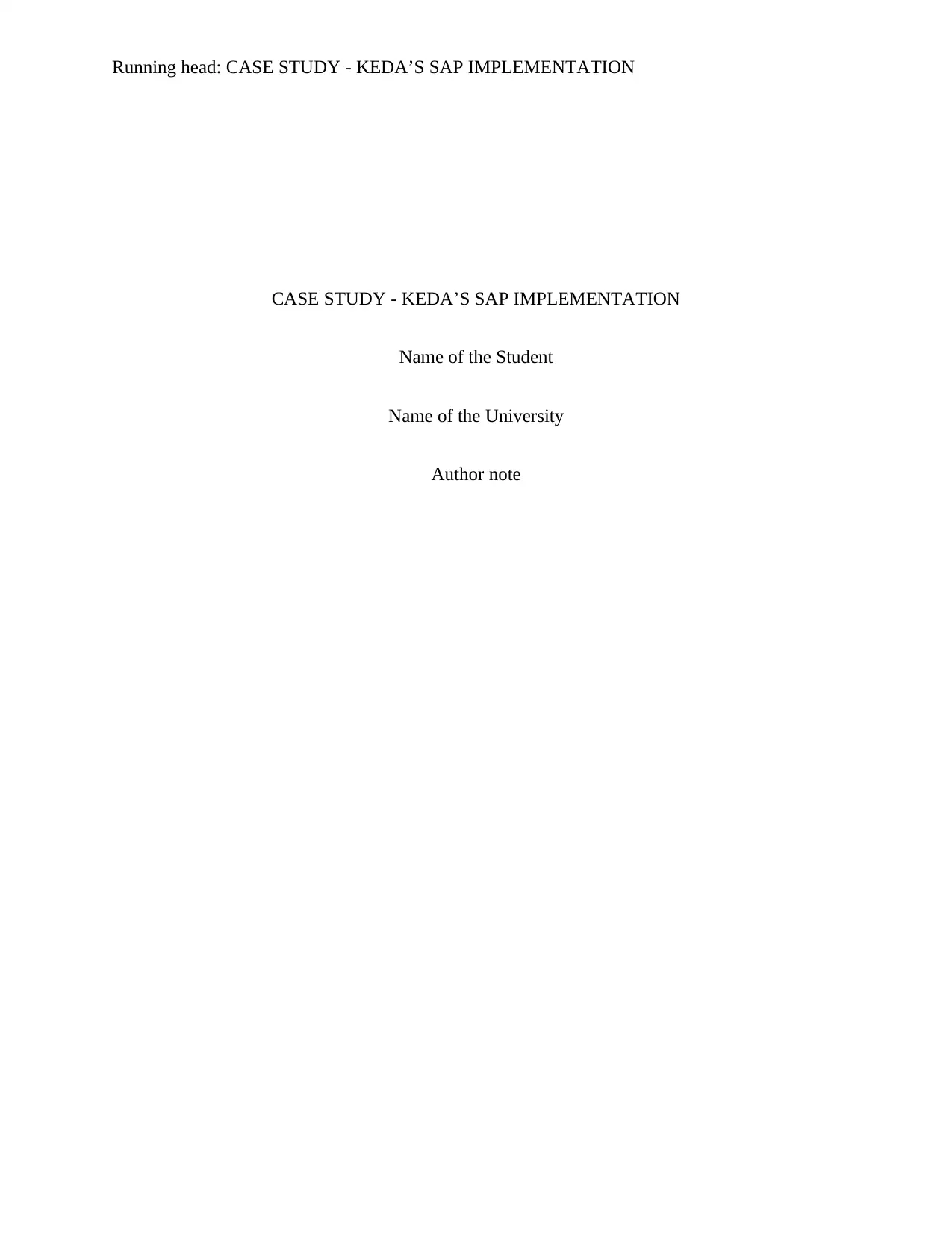
Running head: CASE STUDY - KEDA’S SAP IMPLEMENTATION
CASE STUDY - KEDA’S SAP IMPLEMENTATION
Name of the Student
Name of the University
Author note
CASE STUDY - KEDA’S SAP IMPLEMENTATION
Name of the Student
Name of the University
Author note
Paraphrase This Document
Need a fresh take? Get an instant paraphrase of this document with our AI Paraphraser
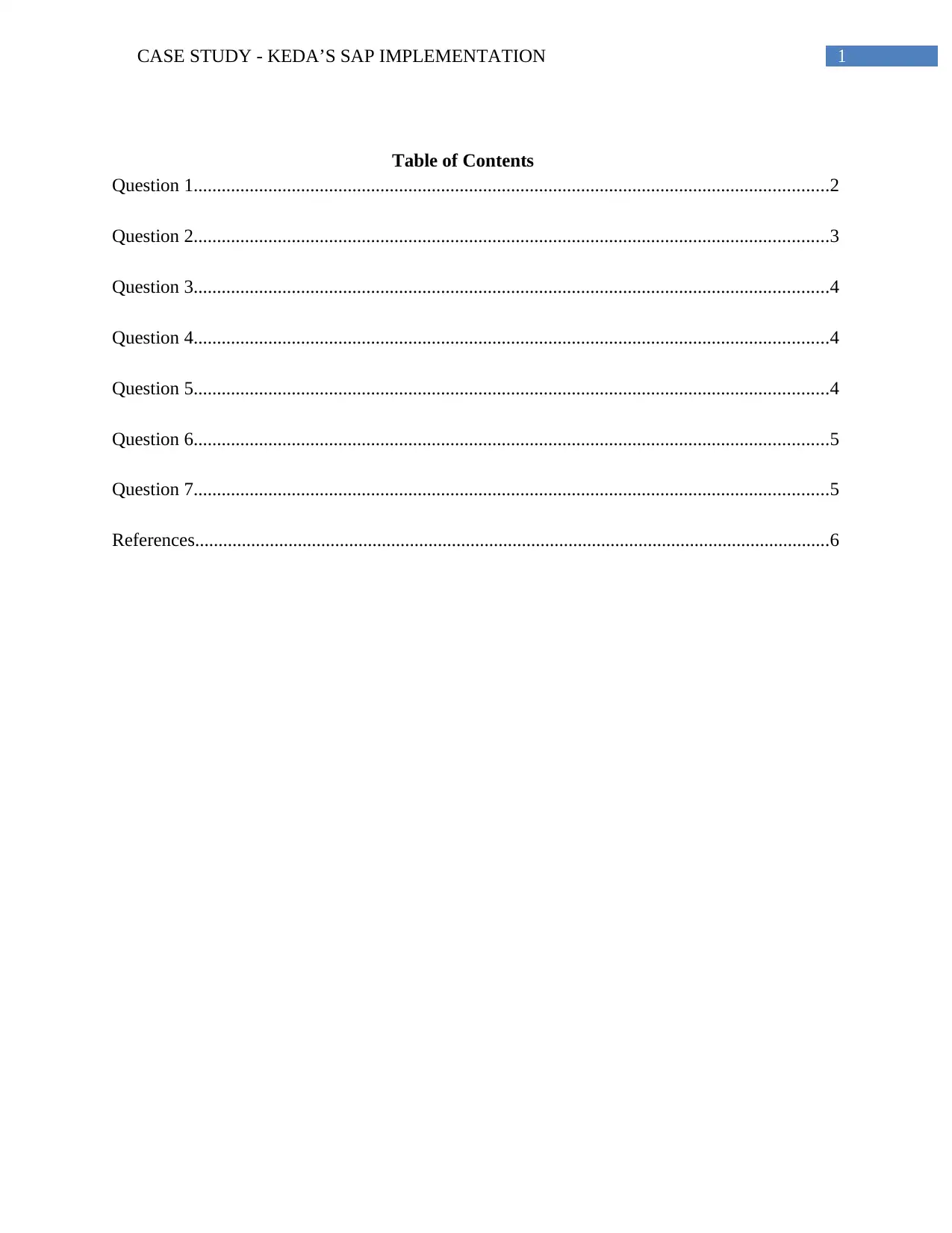
1CASE STUDY - KEDA’S SAP IMPLEMENTATION
Table of Contents
Question 1........................................................................................................................................2
Question 2........................................................................................................................................3
Question 3........................................................................................................................................4
Question 4........................................................................................................................................4
Question 5........................................................................................................................................4
Question 6........................................................................................................................................5
Question 7........................................................................................................................................5
References........................................................................................................................................6
Table of Contents
Question 1........................................................................................................................................2
Question 2........................................................................................................................................3
Question 3........................................................................................................................................4
Question 4........................................................................................................................................4
Question 5........................................................................................................................................4
Question 6........................................................................................................................................5
Question 7........................................................................................................................................5
References........................................................................................................................................6
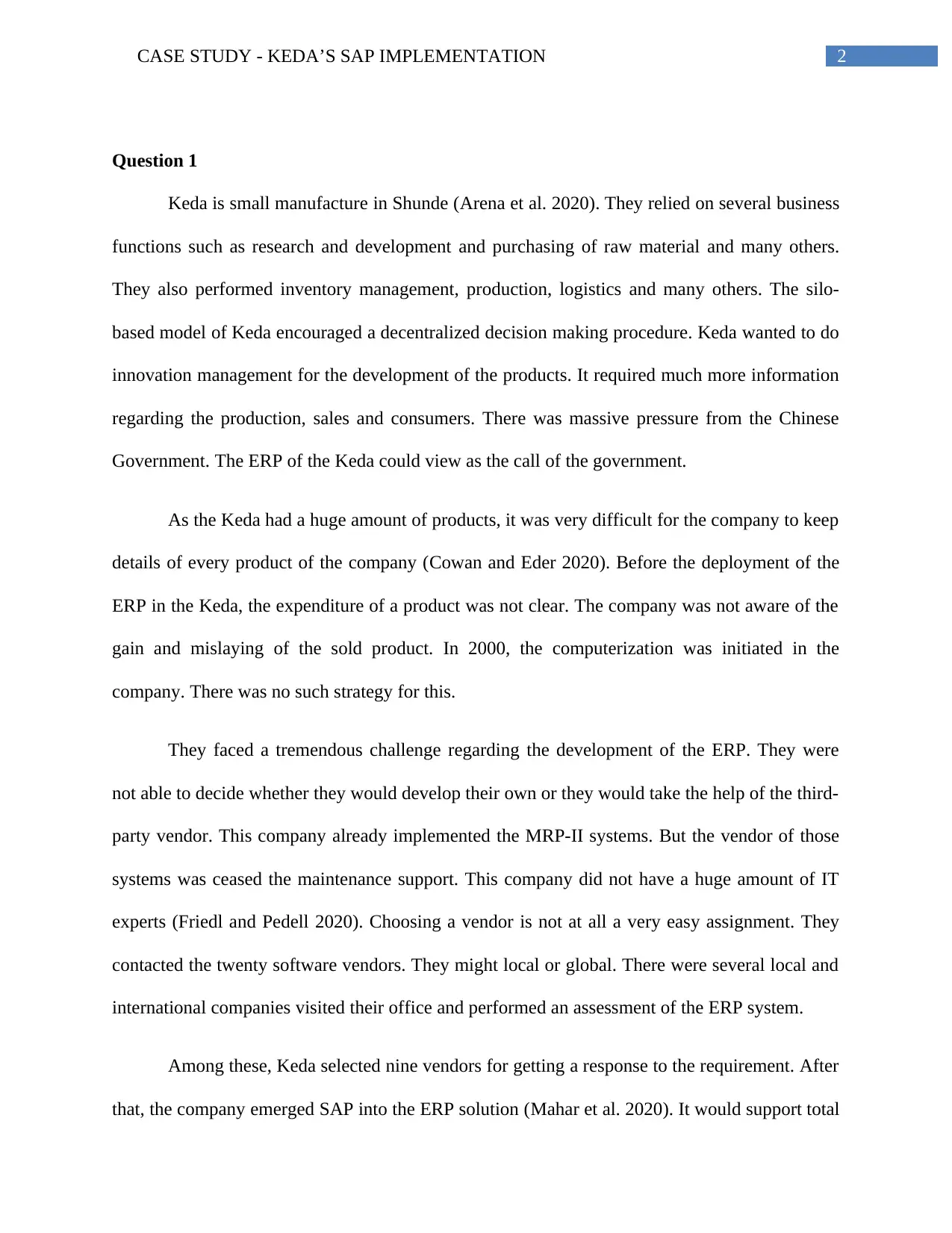
2CASE STUDY - KEDA’S SAP IMPLEMENTATION
Question 1
Keda is small manufacture in Shunde (Arena et al. 2020). They relied on several business
functions such as research and development and purchasing of raw material and many others.
They also performed inventory management, production, logistics and many others. The silo-
based model of Keda encouraged a decentralized decision making procedure. Keda wanted to do
innovation management for the development of the products. It required much more information
regarding the production, sales and consumers. There was massive pressure from the Chinese
Government. The ERP of the Keda could view as the call of the government.
As the Keda had a huge amount of products, it was very difficult for the company to keep
details of every product of the company (Cowan and Eder 2020). Before the deployment of the
ERP in the Keda, the expenditure of a product was not clear. The company was not aware of the
gain and mislaying of the sold product. In 2000, the computerization was initiated in the
company. There was no such strategy for this.
They faced a tremendous challenge regarding the development of the ERP. They were
not able to decide whether they would develop their own or they would take the help of the third-
party vendor. This company already implemented the MRP-II systems. But the vendor of those
systems was ceased the maintenance support. This company did not have a huge amount of IT
experts (Friedl and Pedell 2020). Choosing a vendor is not at all a very easy assignment. They
contacted the twenty software vendors. They might local or global. There were several local and
international companies visited their office and performed an assessment of the ERP system.
Among these, Keda selected nine vendors for getting a response to the requirement. After
that, the company emerged SAP into the ERP solution (Mahar et al. 2020). It would support total
Question 1
Keda is small manufacture in Shunde (Arena et al. 2020). They relied on several business
functions such as research and development and purchasing of raw material and many others.
They also performed inventory management, production, logistics and many others. The silo-
based model of Keda encouraged a decentralized decision making procedure. Keda wanted to do
innovation management for the development of the products. It required much more information
regarding the production, sales and consumers. There was massive pressure from the Chinese
Government. The ERP of the Keda could view as the call of the government.
As the Keda had a huge amount of products, it was very difficult for the company to keep
details of every product of the company (Cowan and Eder 2020). Before the deployment of the
ERP in the Keda, the expenditure of a product was not clear. The company was not aware of the
gain and mislaying of the sold product. In 2000, the computerization was initiated in the
company. There was no such strategy for this.
They faced a tremendous challenge regarding the development of the ERP. They were
not able to decide whether they would develop their own or they would take the help of the third-
party vendor. This company already implemented the MRP-II systems. But the vendor of those
systems was ceased the maintenance support. This company did not have a huge amount of IT
experts (Friedl and Pedell 2020). Choosing a vendor is not at all a very easy assignment. They
contacted the twenty software vendors. They might local or global. There were several local and
international companies visited their office and performed an assessment of the ERP system.
Among these, Keda selected nine vendors for getting a response to the requirement. After
that, the company emerged SAP into the ERP solution (Mahar et al. 2020). It would support total
⊘ This is a preview!⊘
Do you want full access?
Subscribe today to unlock all pages.

Trusted by 1+ million students worldwide
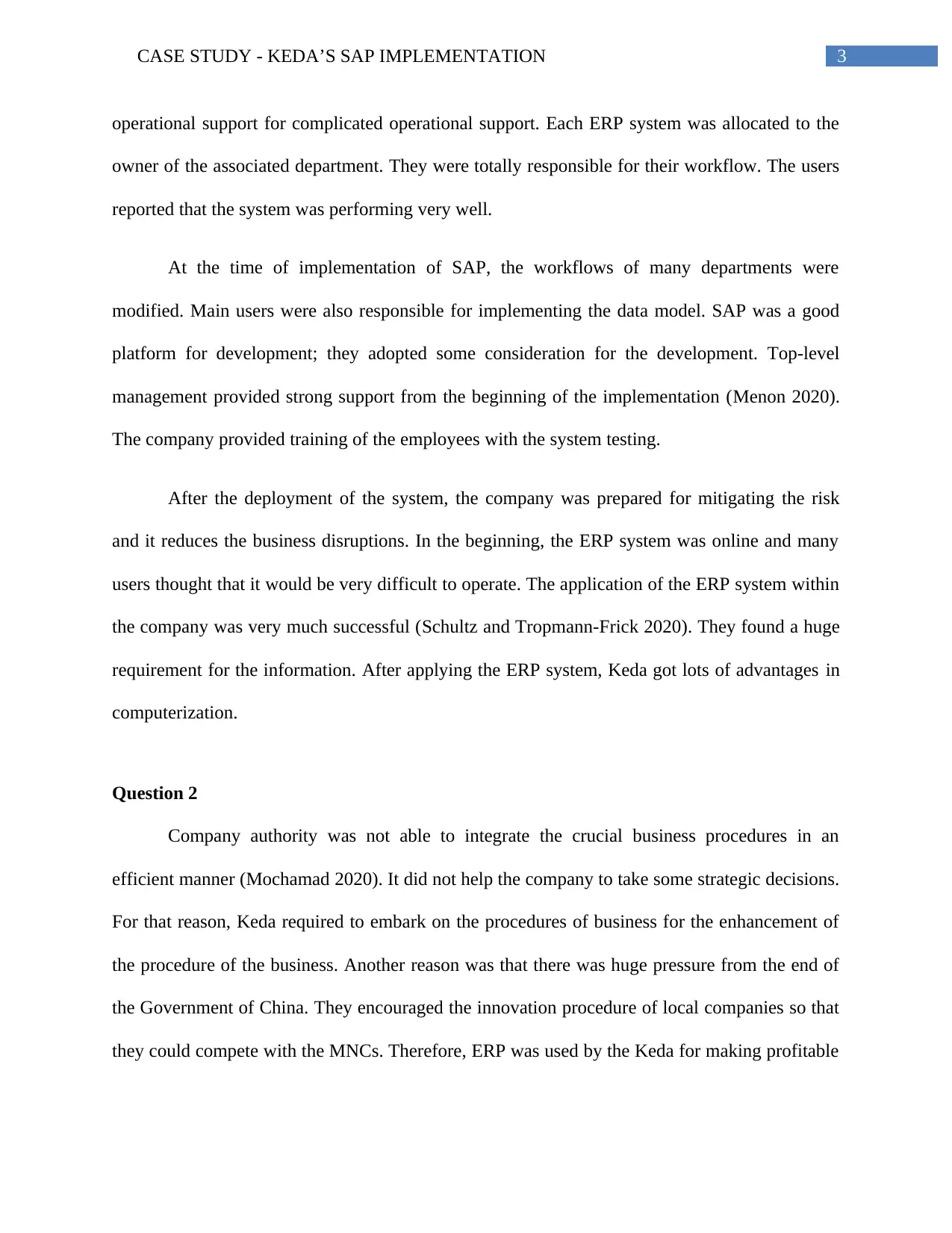
3CASE STUDY - KEDA’S SAP IMPLEMENTATION
operational support for complicated operational support. Each ERP system was allocated to the
owner of the associated department. They were totally responsible for their workflow. The users
reported that the system was performing very well.
At the time of implementation of SAP, the workflows of many departments were
modified. Main users were also responsible for implementing the data model. SAP was a good
platform for development; they adopted some consideration for the development. Top-level
management provided strong support from the beginning of the implementation (Menon 2020).
The company provided training of the employees with the system testing.
After the deployment of the system, the company was prepared for mitigating the risk
and it reduces the business disruptions. In the beginning, the ERP system was online and many
users thought that it would be very difficult to operate. The application of the ERP system within
the company was very much successful (Schultz and Tropmann-Frick 2020). They found a huge
requirement for the information. After applying the ERP system, Keda got lots of advantages in
computerization.
Question 2
Company authority was not able to integrate the crucial business procedures in an
efficient manner (Mochamad 2020). It did not help the company to take some strategic decisions.
For that reason, Keda required to embark on the procedures of business for the enhancement of
the procedure of the business. Another reason was that there was huge pressure from the end of
the Government of China. They encouraged the innovation procedure of local companies so that
they could compete with the MNCs. Therefore, ERP was used by the Keda for making profitable
operational support for complicated operational support. Each ERP system was allocated to the
owner of the associated department. They were totally responsible for their workflow. The users
reported that the system was performing very well.
At the time of implementation of SAP, the workflows of many departments were
modified. Main users were also responsible for implementing the data model. SAP was a good
platform for development; they adopted some consideration for the development. Top-level
management provided strong support from the beginning of the implementation (Menon 2020).
The company provided training of the employees with the system testing.
After the deployment of the system, the company was prepared for mitigating the risk
and it reduces the business disruptions. In the beginning, the ERP system was online and many
users thought that it would be very difficult to operate. The application of the ERP system within
the company was very much successful (Schultz and Tropmann-Frick 2020). They found a huge
requirement for the information. After applying the ERP system, Keda got lots of advantages in
computerization.
Question 2
Company authority was not able to integrate the crucial business procedures in an
efficient manner (Mochamad 2020). It did not help the company to take some strategic decisions.
For that reason, Keda required to embark on the procedures of business for the enhancement of
the procedure of the business. Another reason was that there was huge pressure from the end of
the Government of China. They encouraged the innovation procedure of local companies so that
they could compete with the MNCs. Therefore, ERP was used by the Keda for making profitable
Paraphrase This Document
Need a fresh take? Get an instant paraphrase of this document with our AI Paraphraser

4CASE STUDY - KEDA’S SAP IMPLEMENTATION
innovation. They also faced some crucial challenges for inventory management. For that reason,
the company required to deploy the ERP system.
Question 3
The initial procedure was to select the vendor for the development of the ERP system. It
helped to choose the most appropriate developer for the ERP system. A second procedure was to
arrange the development team for ERP software development. It helped to bring all the important
stakeholders (Menon 2020). They could assure the company for applying and executing the
project. It engaged all the consultants, IT officials and key players of this project. In the end, the
implementation of the system was skilled by applying SAP. It made sure that the operation
would be efficient. It was changed for making the system congruent with ERP.
Question 4
The main best practice of the leaders was to create the procedure. Leaders of the Keda
were responsible to provide many principles. With the help of those principles, Keda might reach
to their target. It could be done with the help of an ERP system. The top-level management of
Keda set some temporary targets for the staff of Keda (Mahar et al. 2020). These targets were
helped the Keda to reach to their short term goals. These targets helped to reach greater
objectives. Leaders encouraged assistance and formed motivated teams. These helped the
company to reach the target of Keda. Thirdly, the leader encouraged the procedure of
modification by pushing innovation. It helped to improve the operation within Keda.
Question 5
Challenges faced by the Keda are as follows:
innovation. They also faced some crucial challenges for inventory management. For that reason,
the company required to deploy the ERP system.
Question 3
The initial procedure was to select the vendor for the development of the ERP system. It
helped to choose the most appropriate developer for the ERP system. A second procedure was to
arrange the development team for ERP software development. It helped to bring all the important
stakeholders (Menon 2020). They could assure the company for applying and executing the
project. It engaged all the consultants, IT officials and key players of this project. In the end, the
implementation of the system was skilled by applying SAP. It made sure that the operation
would be efficient. It was changed for making the system congruent with ERP.
Question 4
The main best practice of the leaders was to create the procedure. Leaders of the Keda
were responsible to provide many principles. With the help of those principles, Keda might reach
to their target. It could be done with the help of an ERP system. The top-level management of
Keda set some temporary targets for the staff of Keda (Mahar et al. 2020). These targets were
helped the Keda to reach to their short term goals. These targets helped to reach greater
objectives. Leaders encouraged assistance and formed motivated teams. These helped the
company to reach the target of Keda. Thirdly, the leader encouraged the procedure of
modification by pushing innovation. It helped to improve the operation within Keda.
Question 5
Challenges faced by the Keda are as follows:
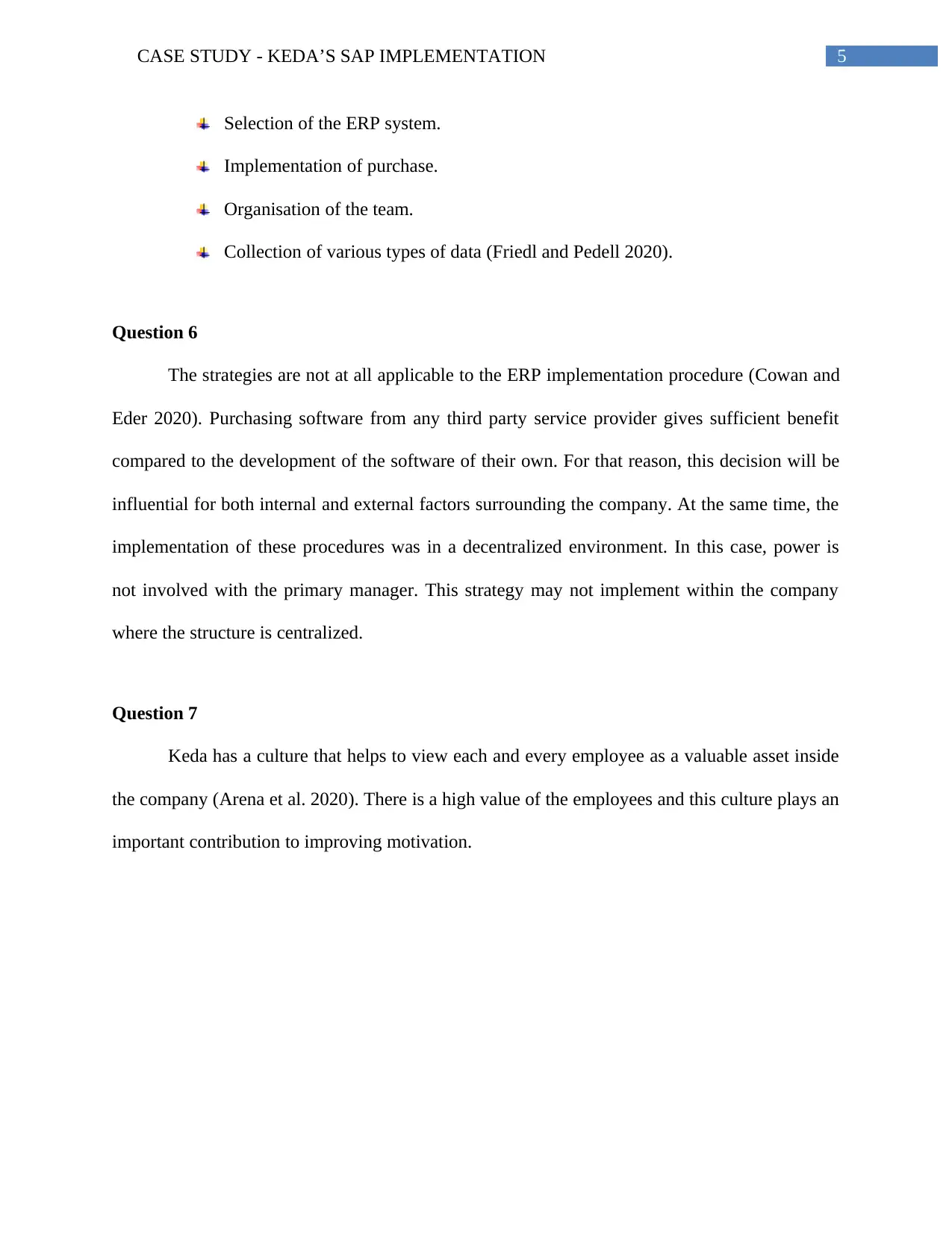
5CASE STUDY - KEDA’S SAP IMPLEMENTATION
Selection of the ERP system.
Implementation of purchase.
Organisation of the team.
Collection of various types of data (Friedl and Pedell 2020).
Question 6
The strategies are not at all applicable to the ERP implementation procedure (Cowan and
Eder 2020). Purchasing software from any third party service provider gives sufficient benefit
compared to the development of the software of their own. For that reason, this decision will be
influential for both internal and external factors surrounding the company. At the same time, the
implementation of these procedures was in a decentralized environment. In this case, power is
not involved with the primary manager. This strategy may not implement within the company
where the structure is centralized.
Question 7
Keda has a culture that helps to view each and every employee as a valuable asset inside
the company (Arena et al. 2020). There is a high value of the employees and this culture plays an
important contribution to improving motivation.
Selection of the ERP system.
Implementation of purchase.
Organisation of the team.
Collection of various types of data (Friedl and Pedell 2020).
Question 6
The strategies are not at all applicable to the ERP implementation procedure (Cowan and
Eder 2020). Purchasing software from any third party service provider gives sufficient benefit
compared to the development of the software of their own. For that reason, this decision will be
influential for both internal and external factors surrounding the company. At the same time, the
implementation of these procedures was in a decentralized environment. In this case, power is
not involved with the primary manager. This strategy may not implement within the company
where the structure is centralized.
Question 7
Keda has a culture that helps to view each and every employee as a valuable asset inside
the company (Arena et al. 2020). There is a high value of the employees and this culture plays an
important contribution to improving motivation.
⊘ This is a preview!⊘
Do you want full access?
Subscribe today to unlock all pages.

Trusted by 1+ million students worldwide
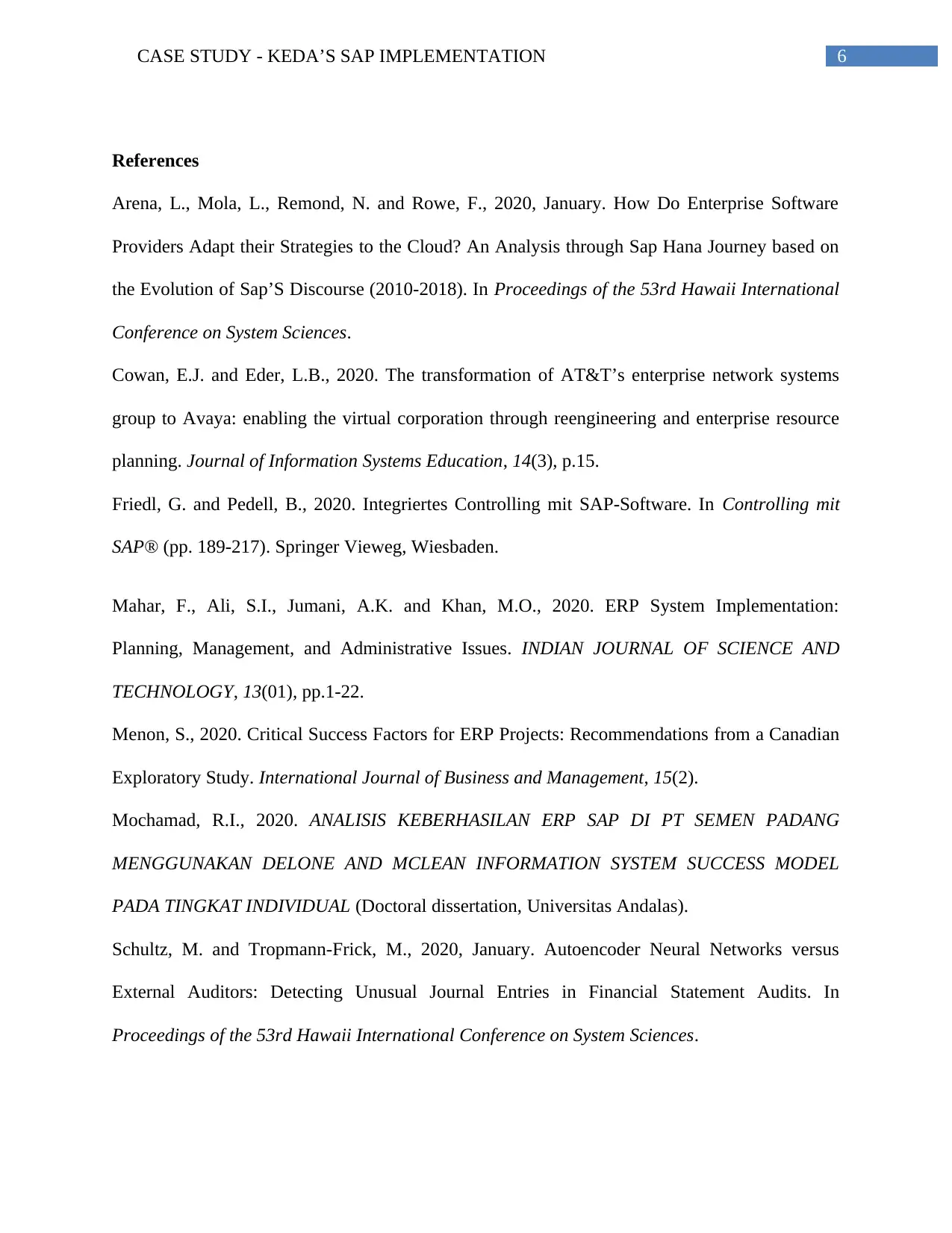
6CASE STUDY - KEDA’S SAP IMPLEMENTATION
References
Arena, L., Mola, L., Remond, N. and Rowe, F., 2020, January. How Do Enterprise Software
Providers Adapt their Strategies to the Cloud? An Analysis through Sap Hana Journey based on
the Evolution of Sap’S Discourse (2010-2018). In Proceedings of the 53rd Hawaii International
Conference on System Sciences.
Cowan, E.J. and Eder, L.B., 2020. The transformation of AT&T’s enterprise network systems
group to Avaya: enabling the virtual corporation through reengineering and enterprise resource
planning. Journal of Information Systems Education, 14(3), p.15.
Friedl, G. and Pedell, B., 2020. Integriertes Controlling mit SAP-Software. In Controlling mit
SAP® (pp. 189-217). Springer Vieweg, Wiesbaden.
Mahar, F., Ali, S.I., Jumani, A.K. and Khan, M.O., 2020. ERP System Implementation:
Planning, Management, and Administrative Issues. INDIAN JOURNAL OF SCIENCE AND
TECHNOLOGY, 13(01), pp.1-22.
Menon, S., 2020. Critical Success Factors for ERP Projects: Recommendations from a Canadian
Exploratory Study. International Journal of Business and Management, 15(2).
Mochamad, R.I., 2020. ANALISIS KEBERHASILAN ERP SAP DI PT SEMEN PADANG
MENGGUNAKAN DELONE AND MCLEAN INFORMATION SYSTEM SUCCESS MODEL
PADA TINGKAT INDIVIDUAL (Doctoral dissertation, Universitas Andalas).
Schultz, M. and Tropmann-Frick, M., 2020, January. Autoencoder Neural Networks versus
External Auditors: Detecting Unusual Journal Entries in Financial Statement Audits. In
Proceedings of the 53rd Hawaii International Conference on System Sciences.
References
Arena, L., Mola, L., Remond, N. and Rowe, F., 2020, January. How Do Enterprise Software
Providers Adapt their Strategies to the Cloud? An Analysis through Sap Hana Journey based on
the Evolution of Sap’S Discourse (2010-2018). In Proceedings of the 53rd Hawaii International
Conference on System Sciences.
Cowan, E.J. and Eder, L.B., 2020. The transformation of AT&T’s enterprise network systems
group to Avaya: enabling the virtual corporation through reengineering and enterprise resource
planning. Journal of Information Systems Education, 14(3), p.15.
Friedl, G. and Pedell, B., 2020. Integriertes Controlling mit SAP-Software. In Controlling mit
SAP® (pp. 189-217). Springer Vieweg, Wiesbaden.
Mahar, F., Ali, S.I., Jumani, A.K. and Khan, M.O., 2020. ERP System Implementation:
Planning, Management, and Administrative Issues. INDIAN JOURNAL OF SCIENCE AND
TECHNOLOGY, 13(01), pp.1-22.
Menon, S., 2020. Critical Success Factors for ERP Projects: Recommendations from a Canadian
Exploratory Study. International Journal of Business and Management, 15(2).
Mochamad, R.I., 2020. ANALISIS KEBERHASILAN ERP SAP DI PT SEMEN PADANG
MENGGUNAKAN DELONE AND MCLEAN INFORMATION SYSTEM SUCCESS MODEL
PADA TINGKAT INDIVIDUAL (Doctoral dissertation, Universitas Andalas).
Schultz, M. and Tropmann-Frick, M., 2020, January. Autoencoder Neural Networks versus
External Auditors: Detecting Unusual Journal Entries in Financial Statement Audits. In
Proceedings of the 53rd Hawaii International Conference on System Sciences.
Paraphrase This Document
Need a fresh take? Get an instant paraphrase of this document with our AI Paraphraser

7CASE STUDY - KEDA’S SAP IMPLEMENTATION
Situmorang, P.P., 2020. THE EFFECT OF SYSTEM QUALITY AND INFORMATION
QUALITY ON THE SATISFACTION OF USER ENTERPRISE RESOURCE PLANNING-
SYSTEM APPLICATION AND PRODUCT IN DATA PROCESSING (ERP-SAP) WITH
PERCEIVED USEFULNESS AS A VARIABLE MODERATING IN PTPN III (PERSERO)
UNIT OF LABUHAN. International Journal of Public Budgeting, Accounting and Finance,
2(4), pp.1-11.
Situmorang, P.P., 2020. THE EFFECT OF SYSTEM QUALITY AND INFORMATION
QUALITY ON THE SATISFACTION OF USER ENTERPRISE RESOURCE PLANNING-
SYSTEM APPLICATION AND PRODUCT IN DATA PROCESSING (ERP-SAP) WITH
PERCEIVED USEFULNESS AS A VARIABLE MODERATING IN PTPN III (PERSERO)
UNIT OF LABUHAN. International Journal of Public Budgeting, Accounting and Finance,
2(4), pp.1-11.
1 out of 8
Related Documents
Your All-in-One AI-Powered Toolkit for Academic Success.
+13062052269
info@desklib.com
Available 24*7 on WhatsApp / Email
![[object Object]](/_next/static/media/star-bottom.7253800d.svg)
Unlock your academic potential
Copyright © 2020–2025 A2Z Services. All Rights Reserved. Developed and managed by ZUCOL.





